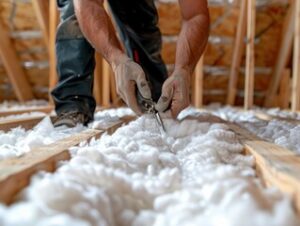Insulating your ceiling helps to keep outside temperatures out, reducing thermal fluctuations that can make rooms feel uncomfortable. It also helps to reduce energy bills.

Insulation prevents moisture accumulation, which can lead to mold growth. It also prevents air leakage and provides a sound barrier. It can be installed in a variety of ways, including foam boards and blown-in insulation. Contact Ceiling Insulation Perth for professional help.
Insulation improves energy efficiency, helping to reduce heating and cooling costs by preventing the escape of warm air in winter and the entry of hot air in summer. Its primary function is to prevent heat from escaping through the ceiling and roof, but it also improves indoor comfort by maintaining a stable temperature, which in turn reduces energy consumption.
When installed properly, Ceiling Insulation will ensure a tight, well-sealed envelope, reducing energy loss and ensuring that mechanical ventilation systems work efficiently. In fact, when used to its full potential, insulation can help reduce energy consumption and utility bills by up to 30%.
There are many different types of ceiling insulation, each with their own advantages and disadvantages. Insulation is measured by its R-value, which identifies how much resistance it offers to heat flow. The higher the R-value, the better the insulation is.
The type of insulation you choose depends on several factors, including your budget and the climate in which you live. For example, if you are aiming for maximum thermal performance, mineral wool insulation is an excellent option. It is available in pre-cut batts that fit standard joist spacing, and it performs efficiently in most applications.
If you are working on a tight budget, fiberglass insulation is an affordable choice that still provides high levels of thermal resistance. It is also an effective acoustic insulator, reducing sound transmission between floors, making it ideal for residential use.
When it comes to multi-storey buildings, insulating the ceiling is often a priority. It can be difficult to control the temperature in rooms on different levels, and the insulation helps keep a consistent level of warmth throughout the building.
The right insulation can also make a difference when it comes to fire safety. It slows the spread of fire, which gives residents more time to escape a burning home or office. This is especially important in areas where people work, such as commercial offices and hospitals. For this reason, it is essential that a fire-rated insulation material be selected.
Increased Comfort
Ceiling Insulation is one of the easiest ways to reduce energy bills and make your home more comfortable all year round. It’s also a good way to meet and exceed local living standards and sustainability schemes.
Without insulation, heat can escape through the ceiling into lower levels of your home, forcing your HVAC system to work overtime to maintain a comfortable temperature. By adding insulation to your ceiling, you create an effective barrier that keeps warm air in during cold NEPA winters and hot air out during the summer, reducing energy consumption and saving money.
Aside from helping to regulate temperature in your home, proper insulation also helps to minimise noise. In addition, some types of insulation are also fire retardant and can help to prevent drafts, dust, moisture and other contaminants from entering your living space.
Adding ceiling insulation is a great idea whether you are renovating your home or building new. This is especially true if the existing ceiling insulation is not adequate or has become compressed over time, which can significantly reduce its effectiveness. It’s a relatively simple project that can be done DIY, though we recommend working with experienced professionals who have the right tools and equipment to ensure a safe, successful and durable installation.
There are several different types of ceiling insulation available, each with their own unique advantages and benefits. Fiberglass batt insulation is a popular choice, as it’s cost-effective, easy to install and non-combustible. Spray foam insulation is another option, as it can effectively seal gaps and cracks and offers excellent soundproofing.
Insulating your ceiling will not only improve your home’s comfort and energy efficiency, but it will also add value to your property and may even increase its marketability if you decide to sell in the future. In fact, many regions require that insulation be installed in new construction and renovations as a part of building codes and regulations.
If you are considering upgrading your home’s insulation, contact us at Koala Insulation to see what options are available. We are proud to provide a wide range of high-quality products that can be used to achieve optimal thermal performance and enhance indoor comfort. We look forward to helping you keep your energy costs low and your home comfortable!
Reduced Energy Bills
Ceiling insulation reduces your energy bills because it helps to keep your home at a comfortable temperature all year round. It does this by reducing conductive heat transfer and trapping cool air in the summer, making it less strain on your heating and cooling systems. Moreover, it prevents drafts and keeps moisture from entering your home, which can lead to mold and other health problems.
In addition to reducing your energy bills, ceiling insulation can also protect your HVAC ducts from damage due to extreme temperatures. The ducts are usually located in the attic and if your attic is well-insulated, they’ll be less likely to become damaged due to high or low temperatures.
Insulation in the attic is especially important if your heating and cooling system runs through it. This is because if your attic isn’t properly insulated, heat will escape through the roof and the air conditioner will have to work harder to cool the house. Moreover, the insulation will help to prevent ice dams from forming on your roof and damaging your home.
Lastly, ceiling insulation can reduce the amount of greenhouse gas emissions that your home produces. This is because fewer energy sources will be needed to power your home, which will in turn reduce the amount of carbon dioxide that is released into the atmosphere. In addition, if you’re a homeowner in the state of Massachusetts, you can save between 75% and 100% on insulation installation costs by installing it through Mass Save, an energy efficiency program for homeowners.
Suitable ceiling heat insulation is not only a great energy-saving option but also provides several other benefits, such as sound reduction and improved acoustics in a space. It’s important to note that insulation solutions can vary based on your climate zone, so be sure to choose the best type of insulation for your home. Contact Rubcorp today for a free consultation and start saving money and living more comfortably!
Reduced Carbon Emissions
Effective insulation helps reduce carbon emissions by decreasing the need to burn fossil fuels for heating and cooling. This decrease in energy usage directly correlates to decreased carbon dioxide emissions, which are a major contributing factor to climate change.
However, not all insulation is created equal. Different insulation materials have varying embodied carbon levels, which is the total amount of greenhouse gases emitted by the material over its lifetime. This metric takes into account the production of the material as well as any other pollutants it may produce or release into the environment.
Fortunately, the majority of insulation in homes and commercial buildings is made from natural materials such as fiberglass, cellulose, or foam glass. These materials have low embodied carbon compared to synthetic insulation products like extruded polystyrene (XPS) and spray foam. These synthetic insulation products are manufactured by mixing petrochemical-based resins with blowing agents that cause them to expand. While international agreements are limiting the use of high GWP blowing agents, the embodied carbon levels of these insulation products remain higher than other types.
Additionally, some of the highest embodied carbon levels come from the manufacture of some insulation products using petroleum-based polymers. This is particularly true for blown cellulose, which is produced by mixing plant matter such as wheat straw, corn stalks, or cotton linters with a liquid plasticizer that is then heated and injected into a mold. Luckily, this type of insulation is increasingly being replaced by more environmentally friendly options, such as polyiso and EPS which are both made from recycled plastics.
Finally, a major benefit of insulating your home or business is that it can help prevent condensation and moisture buildup on walls and ceilings which may contribute to wood rot or other costly damage. This problem is particularly common in uninsulated homes and can be exacerbated by leaky windows and doors. Proper insulation can keep the interior of your building dry and comfortable, saving you money on energy bills and extending the life of your roof.
By lowering the demand for energy for heating and cooling, insulation can significantly lower your carbon footprint while providing comfort throughout the year. However, it’s important to ensure that you’re choosing a product with the right performance for your project. A good way to do this is to compare the operational savings versus the embodied carbon of various insulation products. This will help you choose a product that is both economical and environmentally sustainable.

